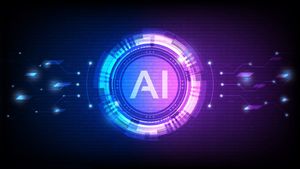
The investment narrative surrounding Artificial Intelligence (AI) is undergoing a profound transformation, moving beyond the singular focus on the "Magnificent Seven" tech behemoths that have dominated headlines and market gains. A new era is dawning where capital is increasingly flowing into a wider array of companies pivotal to the AI buildout, encompassing critical software providers, robust cybersecurity firms, and essential infrastructure developers. This diversification signals a maturing AI market, where the technology is transitioning from a speculative frontier into a foundational layer across numerous industries, with immediate and far-reaching implications for financial markets and corporate strategies.
This shift signifies a crucial evolution in how investors perceive and engage with AI. No longer confined to a handful of industry giants, the AI trade is broadening its scope, reflecting the pervasive integration of AI into the global economy. This heralds a more sustainable and distributed growth model, promising to unlock new avenues for innovation and investment beyond the established leaders.
The Great Diversification: How AI Investment is Redefining Market Dynamics
The AI investment landscape, once heavily concentrated in a select group of mega-cap technology companies—namely Apple (NASDAQ: AAPL), Microsoft (NASDAQ: MSFT), Alphabet (NASDAQ: GOOGL), Amazon (NASDAQ: AMZN), Meta Platforms (NASDAQ: META), Nvidia (NASDAQ: NVDA), and Tesla (NASDAQ: TSLA)—is now experiencing a significant broadening of focus. This pivotal shift is not merely a reallocation of existing capital but represents a fundamental re-evaluation of where true value will be created in the burgeoning AI economy.
The movement began subtly in late 2024 and gained considerable momentum into 2025, driven by the realization that AI's full potential can only be unlocked through a robust ecosystem of enabling technologies and services. The initial surge saw unprecedented investments in foundational AI models and high-performance computing hardware, primarily benefiting chipmakers like Nvidia (NASDAQ: NVDA). However, as Generative AI evolved from a nascent technology to a critical business infrastructure, the demand for specialized software, secure environments, and scalable infrastructure escalated dramatically. U.S. companies alone are projected to invest over $300 billion in AI in 2025, with a staggering 78% of organizations planning to increase their AI spending.
Key players driving this diversification include not only the hyperscalers continuing their massive capital expenditures in cloud and AI infrastructure but also a growing cohort of specialized firms. Software companies like Salesforce (NYSE: CRM) and Adobe (NASDAQ: ADBE) are rapidly integrating AI into their core product offerings, transforming enterprise operations and customer engagement. Simultaneously, cybersecurity firms, facing an escalating threat landscape exacerbated by AI, are investing heavily in AI-powered defense mechanisms, with the global market for AI in cybersecurity projected to reach $146.5 billion by 2034. Initial market reactions have been overwhelmingly positive for these emerging beneficiaries, with increased investor interest and, in many cases, significant share price appreciation as analysts begin to acknowledge the broader distribution of AI-driven revenue growth. This broadening out of the AI trade is now a central market theme for 2025, signaling a more mature and distributed phase of AI adoption.
Who Gains and Who Stumbles: Navigating the AI Gold Rush Beyond the Giants
The seismic shift in AI investment patterns is creating a clear delineation between the potential winners and losers across various sectors, extending far beyond the initial beneficiaries. While the "Magnificent Seven" continue to play a pivotal role, the broadening of the AI trade is spotlighting new contenders and challenging the complacency of others. Investors are now keenly scrutinizing companies based on their strategic AI integration, foundational contributions to the AI ecosystem, and ability to adapt to rapid technological evolution.
In the software sector, companies aggressively embedding AI into their products and developing new AI-powered applications are emerging as clear winners. Microsoft (NASDAQ: MSFT), for instance, continues to solidify its position by integrating AI, notably its Copilot for Microsoft 365, across its vast product portfolio and leveraging its Azure OpenAI services, which boast over 65% of Fortune 500 companies as customers. Alphabet (NASDAQ: GOOGL) is another frontrunner, deepening its AI capabilities across its cloud services and search, evidenced by its $10 billion cloud agreement with Meta Platforms (NASDAQ: META). Specialized AI firms like Palantir Technologies (NYSE: PLTR), with its AI Platform (AIP) enabling complex data integration for large organizations including the U.S. military, are seeing substantial sales increases. Conversely, traditional software stalwarts like Salesforce (NYSE: CRM), Adobe (NASDAQ: ADBE), and ServiceNow (NYSE: NOW) have faced investor skepticism, with their stock prices experiencing significant drops (over 16% collectively) as the market questions their ability to quickly adapt and fend off AI-native competitors. These companies risk losing market share if they cannot seamlessly integrate AI or if hyper-scalers offer similar services at lower costs, potentially "obliterating" traditional business models.
The cybersecurity industry is another battleground for AI. Companies like CrowdStrike Holdings Inc. (NASDAQ: CRWD) are demonstrating robust performance, with investors viewing AI as an indispensable component of their endpoint protection and overall security frameworks. CrowdStrike's AI-driven threat intelligence and automated response capabilities provide a significant competitive edge, leading to accelerated revenue growth (21% in Q2). Firms slow to adopt AI or unable to keep pace with AI-powered cyber threats, however, risk their offerings becoming obsolete against more advanced, proactive solutions.
The insatiable power demands of AI data centers are transforming the utilities and energy sectors into unexpected beneficiaries. Companies like Powell Industries, Inc. (NASDAQ: POWL), which designs electrical equipment for power management, are experiencing record earnings and robust backlogs due to surging demand from data center construction. Similarly, companies like BioLargo (OTCQB: BLGO) in environmental services and NANO Nuclear Energy (NASDAQ: NNE) are attracting interest for their energy storage and advanced nuclear solutions designed to power these energy-intensive facilities. On the flip side, some uranium investors, like Yellow Cake (LSE: YCA), have seen share price weakness, reflecting concerns that the anticipated surge in nuclear demand from AI might not materialize as quickly as projected, highlighting the risks of inflated expectations in infrastructure plays.
Finally, the semiconductor ecosystem continues its rapid evolution. Nvidia (NASDAQ: NVDA) remains the dominant force, the "heartbeat of the AI investment bonanza," with its data center business driving phenomenal revenue growth. Taiwan Semiconductor Manufacturing Company (NYSE: TSM), as the primary foundry for advanced AI chips, including Nvidia's GPUs, is also an indispensable winner. Broadcom (NASDAQ: AVGO) is emerging as a significant beneficiary by building custom in-house chips for major AI players. In contrast, Intel (NASDAQ: INTC) continues to grapple with an "existential crisis" in the AI chip market, losing significant share to competitors and facing manufacturing setbacks, reflecting its struggle to adapt to the rapid pace of AI hardware innovation.
Industry Impact and Broader Implications: Reshaping the Economic Fabric
The diversification of AI investment is not merely a financial anecdote; it represents a fundamental reshaping of the global economic fabric, with profound industry impact and broader implications. This trend aligns perfectly with the overarching movement towards enterprise-wide digital transformation, where AI is no longer a standalone technology but an embedded intelligence driving efficiency, innovation, and competitive advantage across every business function.
This event fits into broader industry trends by accelerating the integration of AI from isolated projects into core operational frameworks. The "Magnificent Seven" initially paved the way, demonstrating AI's transformative power, but the current phase signifies a deeper penetration into traditional sectors. For instance, the demand for AI in cybersecurity isn't just about better threat detection; it's about fundamentally re-architecting security postures to be proactive, adaptive, and predictive. Similarly, AI's role in industrial software extends beyond automation to intelligent process optimization and predictive maintenance, creating smarter factories and supply chains. This push for pervasive AI integration is forcing companies across all industries to re-evaluate their technology roadmaps, talent strategies, and even business models, lest they fall behind AI-native competitors.
The ripple effects on competitors and partners are substantial. Companies that fail to either build their own AI capabilities or effectively integrate AI solutions from third-party providers risk significant market erosion. For partners, the shift creates new opportunities for collaboration, particularly for those offering specialized AI consulting, integration, or infrastructure services. Cloud providers (Amazon (NASDAQ: AMZN) AWS, Microsoft (NASDAQ: MSFT) Azure, Alphabet (NASDAQ: GOOGL) Google Cloud) will continue to be critical infrastructure partners, but the demand for niche AI-focused cloud offerings, like those from CoreWeave, will also grow. The intensified competition is not just between product features but increasingly between entire AI-driven ecosystems, pushing companies towards strategic alliances and acquisitions to shore up AI talent and technology.
Regulatory and policy implications are also coming into sharper focus. As AI permeates critical infrastructure and sensitive data domains, governments worldwide are scrambling to develop frameworks around AI ethics, data privacy, security, and algorithmic transparency. The sheer power demands of AI data centers are already prompting discussions around energy policy, grid modernization, and the sourcing of sustainable power, creating new regulatory scrutiny for utilities and tech companies alike. Historically, this broad adoption of a transformative technology mirrors the internet's early days, where initial speculative investment matured into widespread commercial application, eventually necessitating new regulatory paradigms around data, commerce, and digital rights. The lessons from that era suggest that while innovation will continue at a rapid pace, regulatory oversight will inevitably tighten, shaping the long-term trajectory of AI's economic impact.
What Comes Next: Navigating the Future of AI-Driven Growth
The current diversification of AI investment marks a critical inflection point, moving from the initial speculative gold rush towards a more mature and integrated phase. The short-term will likely see continued robust capital expenditure in AI infrastructure, particularly in high-performance computing, data centers, and advanced networking. This will directly benefit semiconductor manufacturers like Nvidia (NASDAQ: NVDA) and Taiwan Semiconductor Manufacturing Company (NYSE: TSM), as well as power and utility providers like Powell Industries (NASDAQ: POWL), as the foundational layers for AI continue to expand rapidly. In parallel, a fierce competition will unfold among software vendors to embed the most effective and efficient AI capabilities into their enterprise applications, driving innovation in areas like generative AI for content creation, intelligent automation for workflows, and advanced analytics for decision-making.
In the long term, we can anticipate a deepening of AI integration across virtually every sector, transforming business models and creating entirely new markets. This will necessitate significant strategic pivots and adaptations. Companies across industries will need to evolve from simply using AI tools to becoming AI-powered enterprises, where AI is central to their product development, customer engagement, and operational efficiency. This will require massive investments in reskilling workforces, developing ethical AI governance frameworks, and fostering cultures of continuous innovation. Businesses that fail to make these adaptations risk obsolescence, as AI-native startups and agile incumbents leverage the technology to disrupt traditional value chains.
Emerging market opportunities will include highly specialized AI applications tailored for niche industries, advanced AI security solutions to combat increasingly sophisticated cyber threats, and novel human-AI collaboration tools that augment human capabilities. The massive energy demands of AI will also spur innovation in sustainable energy solutions and grid management. However, challenges will also emerge, including potential market consolidation as larger players acquire promising AI startups, increasing regulatory pressures around data privacy and AI ethics, and the ongoing talent crunch for skilled AI professionals. Investors should be prepared for potential volatility as the market navigates these opportunities and challenges, with a keen eye on companies demonstrating not just AI adoption, but also clear pathways to profitability and sustainable competitive advantage through AI.
Conclusion: A New Dawn for AI Investment and the Intelligent Economy
The evolving landscape of AI investment signals a profound and irreversible shift in the global economy, moving beyond the concentrated gains of the "Magnificent Seven" to a broader, more distributed network of beneficiaries. This diversification underscores a maturing AI market, where the technology is transcending its experimental phase to become a fundamental, pervasive layer across industries, from enterprise software and cybersecurity to critical infrastructure and utilities. The days of simply investing in the biggest names are giving way to a more nuanced approach, demanding a deeper understanding of the entire AI ecosystem.
The key takeaway is that AI is no longer a peripheral innovation but a central driver of corporate strategy and market value. Companies that are foundational enablers of AI, such as advanced semiconductor manufacturers and cloud infrastructure providers, alongside those that strategically integrate AI to enhance their core operations and product offerings, are poised for significant long-term growth. Conversely, firms that lag in AI adoption, or whose traditional business models are directly threatened by AI-powered disruption, face considerable risks to their market position and financial performance. This dynamic creates both immense opportunities for discerning investors and substantial challenges for those unwilling or unable to adapt.
Moving forward, the market will increasingly reward companies that demonstrate not just AI implementation, but also tangible returns on investment, scalable AI solutions, and robust ethical frameworks. Investors should closely watch for continued capital expenditure trends in AI infrastructure, the emergence of sector-specific AI leaders, and the regulatory responses to AI's expanding influence. The coming months will likely see further evidence of AI's transformative power, not just in headline-grabbing breakthroughs, but in the quiet, profound ways it reshapes competitive landscapes, optimizes operations, and creates new value across the intelligent economy. The AI revolution is broadening, and its lasting impact will be felt across every corner of the market for years to come.







